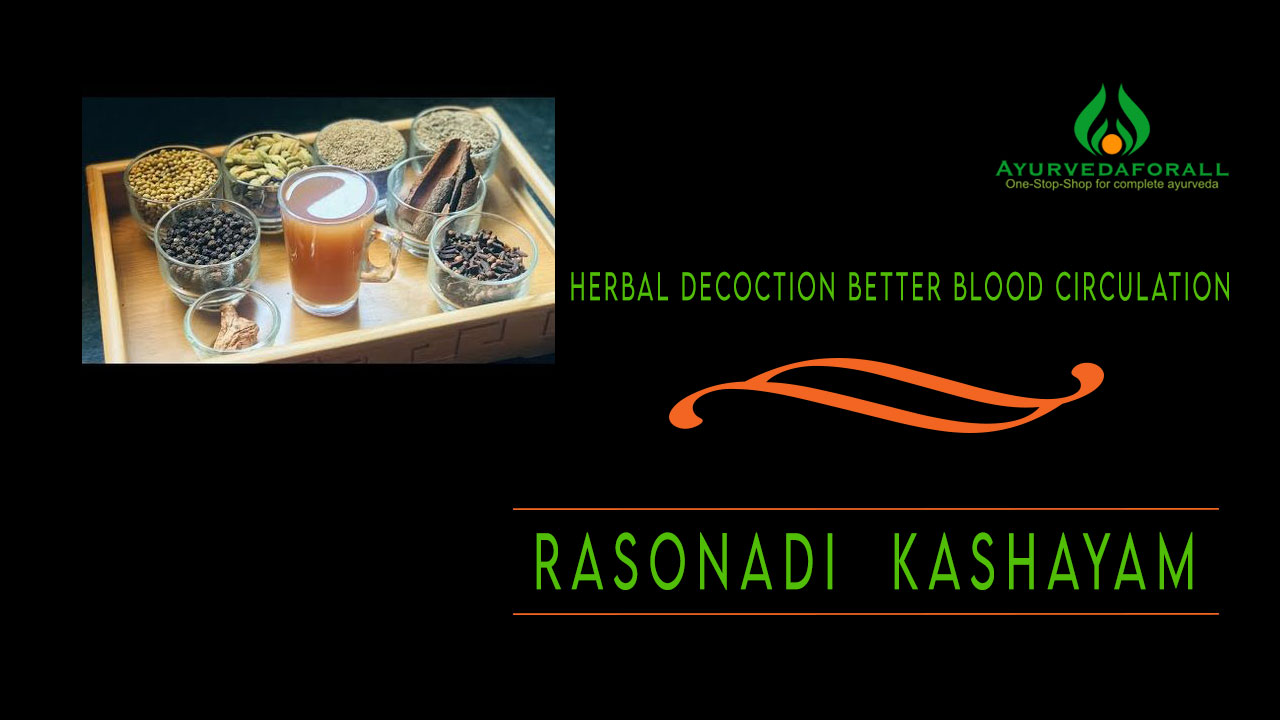
Rasonadi kashayam is an Ayurvedic medicine for many diseases due to obstruction in channels. It is effective from many respiratory diseases to hypertension.
This yogam is specially made by traditional Kerala vaidyas
Benefits of Rasonadi kashayam
It is very effective in chronic upper respiratory tract diseases.
It cures Kaasa swaasa -Cough and breathing difficulties including asthma especially productive cough.
It cures Vaata kopa due to channel obstructions in the body.
Vaatanulomyam (regulating the movements of Vaata) makes the cough and breathing difficulties get relieved.
It is used in the treatment of Hypertension. Helps to reduce atherosclerotic changes.
A main kashaya used in the treatment of heart diseases especially kapha-vaata vitiated conditions.
Indications of Rasonadi kashayam
Unmargagam Vaatam anulomayati kshanat means it brings back the Vaata went into wrong sites back into its own sites.
Ingredients of Rasonadi kashayam
| 1. Garlic | Rasona | Allium sativum L. |
It is used for several conditions linked to the circulatory system and heart, including atherosclerosis, hypercholesterolemia, coronary heart disease and hypertension. It has anti-tumor, anti-microbial and anti-diabetic actions.
| Black cumin seed | Karavi | Nigella sativa |
It is used for headache, toothache, nasal congestion and sinusitis. Beneficial in asthma and intestinal worms.
| 2. Long pepper | Krishna | Piper longum |
It is unctuous and hot in potency with pungent taste but becomes sweet after digestion. It is an aphrodisiac and balances Vata and Kapha.
It improves ability to taste and promotes digestion. Relieves cough cold and other respiratory problems. It is not a laxative, rather causes constipation.
| Sal leaved desmodium | Sthira | Desmodium gangeticum |
It has anthelmintic, anti-catarrhal, carminative, diuretic, expectorant, febrifuge, nervine tonic, anti-diarrheal, and stomachic properties. It is good for the health of heart.
Details of the manufacturing
As already discussed, Rasonadi kashayam has 4 ingredients in equal parts.
Rasona should be taken fresh, while the other 3 ingredients should be washed well and dried up in shade.
Take all the ingredients in crushed form in an earthen pot. For your special attention, Rasona should be crushed and tied up separately in a white clean cotton cloth as a Potali. This is to prevent the excess dissolution of the contents and to maintain the exact consistency of the kashayam. Now add 16 times clean water into it. Make it boil and then cook in the open vessel with low fire. Reduce the quantity into one by eighth of the initial quantity. Make sure to mix it in between with a ladle without breaking the potli. Also, the fire should be kept low to make sure that all the active ingredients in the herbs needed are absorbed well into the water. Once the quantity is reduced to one by eighth of the initial amount of water, remove the vessel from the fire. Squeeze and drain through a clean white cloth. Collect the decoction in a clean vessel and discard the solid waste. Drink the mild warm decoction.
Dosha Dooshya Predominance with roga margas.
Rasonadi kashayam is Kapha-Vaatahara and Anulomana
It acts on aabhyantara rogamarga
Dosage and Usage of Rasonadi kashayam
Dosage: two Pala.
Usage:
Kashayam is advised to take in empty stomach, once the ingested food is digested well and aahaararasa is formed well.
Usage of kashayam with prescribed prakshepadravyas according to the condition of disease and the patient gives the best results mostly.
Exercises and Yoga.
As Rasonadi kashayam targets mainly removing obstructions in channels, regular stretching and mild cardio exercises are advised. Also, specific yogacharya including naadisuddhi pranayama, bhujangaasana, pavanamuktasana is recommended.
Regular exercise helps improve bioavailability of the medicine and food ingested and leads to positive health.
Yoga can maintain harmony within the body and with the surrounding system.
Pavanamuktasana
Nadisudhi pranayama
Bhujangasana
Simple exercises for lungs and heart health
All the exercises and physical exertions must be decided and done under the supervision of a medical expert only.
Recommended diet and behaviour
Diet:
- To be avoided
Heavy meals and difficult to digest foods – cause indigestion.
junk foods- cause disturbance in digestion and reduces the bioavailability of the medicine
carbonated drinks – makes the stomach more acidic and disturbed digestion
refrigerated and frozen foods – causes weak and sluggish digestion by weakening Agni (digestive fire)
Milk and milk products – increase kapha and cause respiratory problems
curd – causes vidaaha and thereby many other diseases
- To be added
Light meals and easily digestible foods
Green gram, soups, honey
freshly cooked and warm food processed with cumin seeds, ginger, black pepper, ajwain etc
Behaviour:
Protect yourself from cold climate.
Better to avoid exposure to excessive sunlight wind rain or dust.
Maintain a regular food and sleep schedule.
Avoid holding or forcing the urges like urine, faeces, cough, sneeze etc.
Side effects and contraindications
No known side effects reported.
People with ulcer or sensitive stomach may develop abdominal pain and other discomforts when taken not under the guidance of a qualified Ayurveda physician.
Classical references
SAHASRAYOGA VAATAVYADHI SHLOKA 3
Equivalent medicines.
Dasamoolakaduthrayam kashayam
Ashtavargam kashayam
Brands Available
AVS Kottakal
Oushadhi
Vaidyaratnam oushadhasala
AVN Madurai
Nagarjuna Ayurveda
Santhigiri ayurveda

